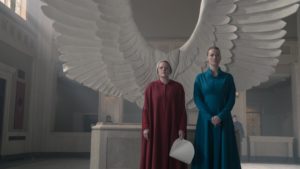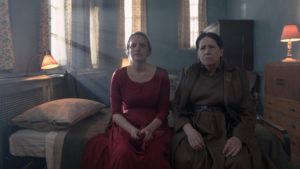The extent of Gilead’s power is never more apparent than in the transformed Washington, D.C. capital seen in “Household.” An episode from the third season of Hulu‘s A Handmaid’s Tale, it shows in vivid detail the aftermath of the United States’ conversion from democracy to a religion-based dictatorship. It was nominated for Outstanding Production Design for a Narrative Contemporary Program (One Hour Or More), an Emmy which Elisabeth Williams won the previous year in the same category.

In Dorothy Fortenberry‘s script, June Offred (played by Elisabeth Moss) is forced to journey to Washington, DC, in a publicity stunt to retrieve her daughter Nichole from Canada. The city has been transformed into a totalitarian nightmare. Ominous flags adorn a modernized Metro Station. The statue in the Lincoln Memorial has been vandalized. The Washington Monument has been altered into a giant cross visible across the city.
Williams achieved the look of the episode under intense time and budgeting pressures. “Sometimes we get our production draft a few weeks before shooting,” she says by telephone. “We will have drawn a list of sets from an outline to start some prep work, but until the director arrives — 18 days before the shoot — everything is in flux. Then, with all the location scouting, the block for the director and DP to create their shot list, and meetings with the various departments, there isn’t much time at all. We’re under the gun every day.”

Remarkably, the crew had one day to shoot the Washington material. Williams accompanied Director Dearbhla Walsh and Cinematographer Stuart Biddlecombe on a scout the previous fall. The team used previz to help position actors, determine what props they could bring, and prepare a shot list. In a separate trip, the visual effects crew filmed the Lincoln Memorial, National Mall, and Washington Monument in 3D. The final results drew inspiration from dictatorships around the world: North Korea, Russia, etc.
“We had two days of prep and one day of shooting,” Williams remembers. “Everything had to run like clockwork.”
The show’s look has evolved in relation to the changes June faces in the plot. Her world has expanded in each of the three seasons, and so have the visuals. As the story moved to Toronto, and to flashbacks in Boston, Williams and her team added colors, sometimes a sense of messiness, to reflect June’s experiences.
Williams is quick to emphasize the collaborative nature of her work, singling out contributions from Art Director Martha Sparrow and Set Decorator Rob Hepburn. “Martha was a godsend,” she says. “She has a background in architecture, and brings both rigor and finesse to the table. Rob has a fine arts and film studies background. He has a deep understanding of the characters and the history we’ve invented for them. I think we are a great team and complement each other well.”
The core production design crew consists of thirty to forty carpenters, painters, set designers, and set dressers. In peak periods the team will grow to more than one hundred workers. Williams points out that many of the crew members have been with The Handmaid’s Tale for two or three seasons. They now have a shorthand for working together and with other departments, like special effects, visual effects, grips, and electrics. Still, time is a constant issue.

As is the fact that key creative members keep changing. Six separate directors worked on the third season, as well as three cinematographers. Each has individual styles and approaches to the material.
“One of the difficulties for the art department is that we work simultaneously with the shooting crew and the prep crew,” Williams says. “My time is always split between the director who’s in prep and the director who’s shooting. It’s hard to pay as much attention as I’d like to both of them. Same with the DPs. It’s a good exercise in diplomacy and psychology.”
The “Household” episode is filled with arresting imagery. The transformed Washington Monument of course, and a National Mall with 200 extras in handmaid’s uniforms arrayed with military precision. Equally striking are the overhead shots, like one that traps characters within the patterns of a tiled floor.
“It’s a collaboration,” Williams repeats. “The director and DP decide how they’re going to shoot their shots, of course, but we collaborate during the location scouts as well. That tiled floor is a good example. We admired it from the balcony and talked about how to best use the space. And as soon as we read the scripts, we start researching and sharing ideas and visuals. We find inspiration from photos or a film or painting. It gets pulled together to create our own vision.”
One of the more unsettling aspects of The Handmaid’s Tale is how reality is converging with its vision of the future.
“The success of the show and its nominations say a lot about how relevant it is,” Williams agrees. “Recently someone on Instagram juxtaposed images from our show with what’s been going on in the news. It’s quite frightening to see how many elements are in place for America to tip into a dictatorship.”

Williams admits that the Covid-19 pandemic has added another layer of difficulty to preparing for Season 4.
“The new safety protocols add a level of difficulty to a job that is quite strenuous to start,” she says. “We’ve only been working for a few weeks, and everyone is feeling the weight of the new rules. We are required to practice physical distancing, wear masks, and work remotely as much as possible. For people who are used to a spontaneous ‘fly by the seat of your pants’ process, it is hard to adjust.’’
Precautions extend from cleaning the furniture and props brought onto sets to shortening production days to hiring real-life couples as extras in scenes requiring a level of intimacy.
“We’re not sure yet how this is going to work,” Williams says. “We’ve already had to shift some scenes that were planned as interiors to exteriors. Of course, some scenes were written to be intimate, and moving them unfortunately changes the nature of the scene and therefore the show.”
Increasing the budget may help mitigate some of the safety issues, but as Williams points out, “It doesn’t matter whether it’s a million-dollar budget, a forty-million-dollar budget or a 200-million-dollar budget—it’s never enough. You always want to do more than what you can afford. And when you don’t have enough time obviously you need more people, which is very expensive. Hard choices always have to be made.
“To be honest, it’s impossible to imagine the extent of the effect Covid-19 will have on our way of doing things,” she adds. “I don’t know how this will work out. Call me back in a month or two and I’ll let you know.”
You can watch The Handmaid’s Tale streaming on Hulu. Also, check out Below the Line’s interview with the show’s VFX Supervisor, Brendan Taylor, here.





